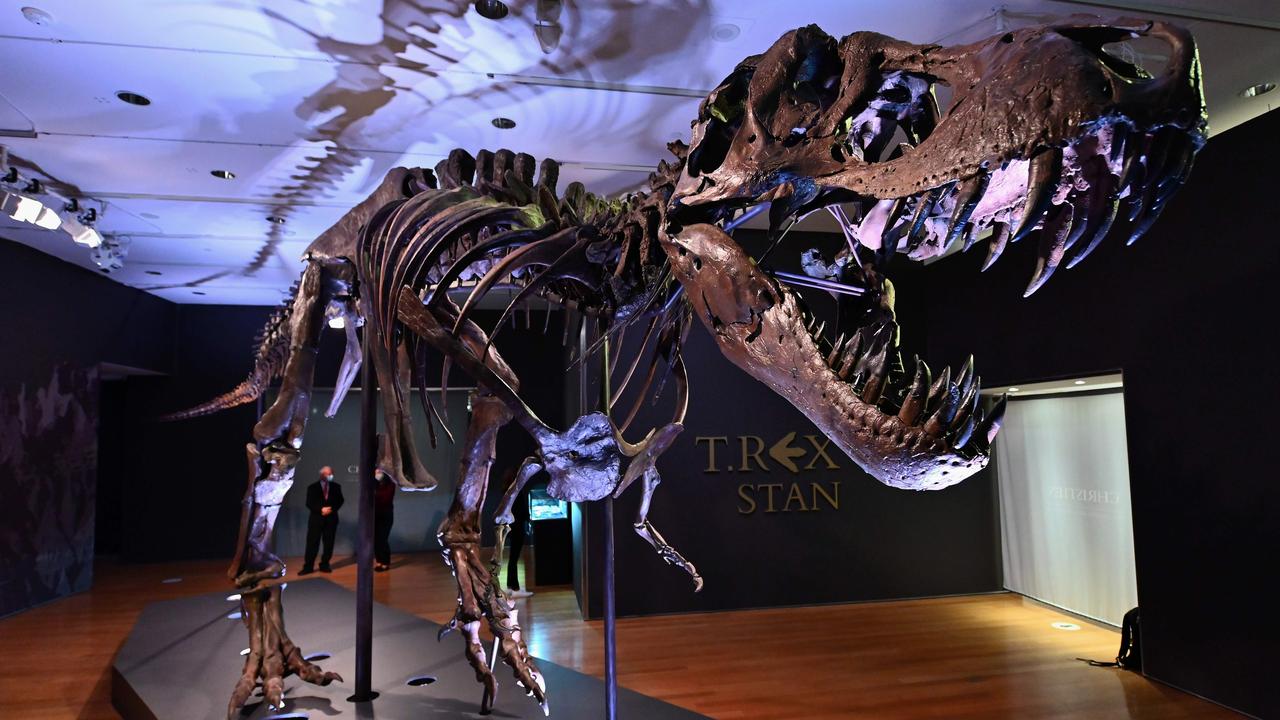Three-in-one Trinity T-rex skeleton sold at auction
A Tyrannosaurus rex skeleton dubbed Trinity because it is made up of bones from three different T-rexes has sold at auction for $9 million

READING LEVEL: GREEN
A Tyrannosaurus rex skeleton, made up of bones from three different T-rexes, has sold at auction for 5.5 million Swiss francs (that’s $9 million Australian or $US6.1 million).
Estimated to be 65 to 67 million years old, the skeleton was sold at the Koller auction house in Zurich, Switzerland, on April 18 after being shipped from the US in nine giant crates.
The skeleton, called Trinity, was put up for sale by an anonymous* American and was bought by a private European collector of modern art and dinosaur relics.
Auctioneer Cyril Koller said it was only the third T-rex skeleton ever sold at auction and the first in Europe.
“It was a wonderful auction because we showed Trinity for two-and-a-half weeks in the concert hall in Zurich. And so more than 30,000 visitors came and admired Trinity; a lot of children,” Mr Koller said.

Mr Koller said he was optimistic* that although the skeleton had been sold to a private buyer, it would remain on public display.
“I’m 100 per cent sure we will see Trinity in the future somewhere again,” he said.
The skeleton measures 3.9m high, 11.6m long and 2.65m wide. As its name suggests, Trinity is made up of bones from three dinosaurs that were excavated* between 2008 and 2013 from the Hell Creek and Lance Creek formations in Montana and Wyoming in the US.
The sites are known for the discoveries of two other significant T-rex skeletons that have gone to auction.
The first, called Sue, sold in 1997 for $US8.4 million, before the second, called Stan, set the world-record auction price when it sold for $US31.8 million at Christie’s auction house in 2020.

University of Maryland vertebrate palaeontologist* Thomas Holtz, who was against the sale of Trinity and other dinosaur specimens, said it was “misleading” and “inappropriate … to combine multiple real bones from different individuals to create a single skeleton”.
There are 293 bones from three dinosaurs in Trinity. Together they make up just over half the skeleton, meaning it is just above the 50 per cent level needed for experts to consider it a high quality specimen.
But Dr Holtz remained sceptical*, saying Trinity “really isn’t a ‘specimen’ so much as it is an art installation”.
He was also unhappy about other auctions of significant dinosaur skeletons and other fossils, which have raked in tens of millions of dollars in recent years.
Experts have warned such trade could be harmful to science by putting the specimens in private hands and out of the reach of researchers.
But Christian Link from the Koller auction house said that 95 per cent of known T-rexes were currently in museums.
GLOSSARY
- anonymous: not identified publicly
- optimistic: hopeful and confident about the future
- excavated: dug up
- vertebrate palaeontologist: scientist who studies the fossils of animals with backbones
- sceptical: having doubts, not convinced
EXTRA READING
67 million-year-old T-rex for sale
Terrifying T-rex teeth hidden behind lips
Dino set to fetch millions of dollars at auction
T-rex called Stan sells for more than $44 million
QUICK QUIZ
- What name has been given to this T-rex skeleton?
- Bones from how many different dinosaurs make up the skeleton?
- How much did the skeleton sell for in Australian dollars?
- Why did Dr Thomas Holtz describe the skeleton as more like an “art installation” than a specimen?
- Why are experts worried that the sale of dinosaur skeletons and other fossils could be harmful to science?
LISTEN TO THIS STORY
CLASSROOM ACTIVITIES
1. Dinosaur collector
This private buyer has spent $9 million Australian dollars on this T-Rex skeleton, what do you think they might plan to do with it?
What would you do with the skeleton if it was given to you?
Do you think it is an accurate representation of a T-rex considering it’s the bones of 3 different dinosaurs? Explain your answer.
Time: allow 20 minutes to complete this activity
Curriculum Links: English, Science, History, Critical and Creative thinking
2. Extension
Who do you think ownership belongs to when important fossils and bones are found around the world?
How do you ensure that important scientific finds are protected and able to be viewed and studied by all?
Time: allow 15 minutes to complete this activity
Curriculum Links: English, Science, Critical and Creative thinking
VCOP ACTIVITY
To sum it up
After reading the article, use your comprehension skills to summarise in a maximum of three sentences what the article is about.
Think about:
- What is the main topic or idea?
- What is an important or interesting fact?
- Who was involved (people or places)?
Use your VCOP skills to re-read your summary to make sure it is clear, specific and well punctuated.

